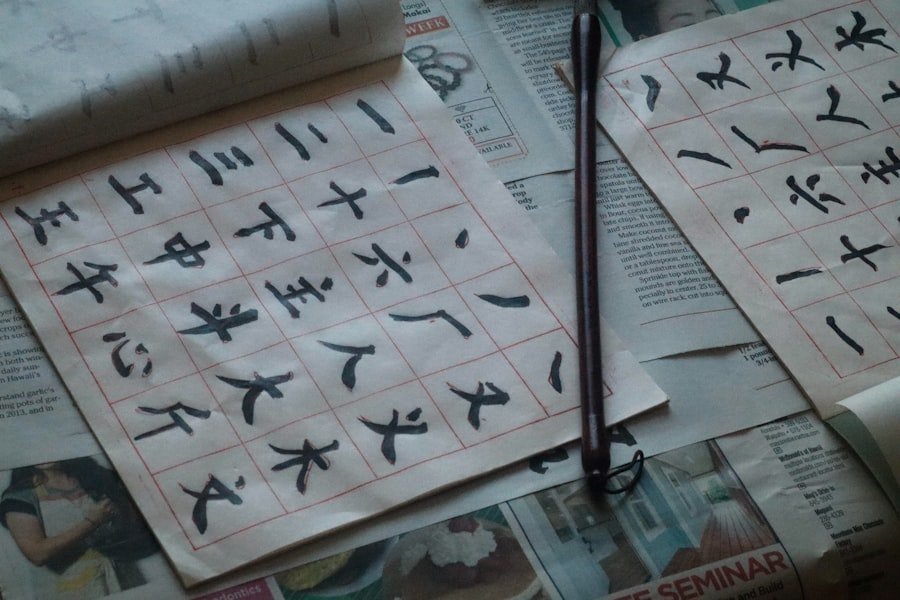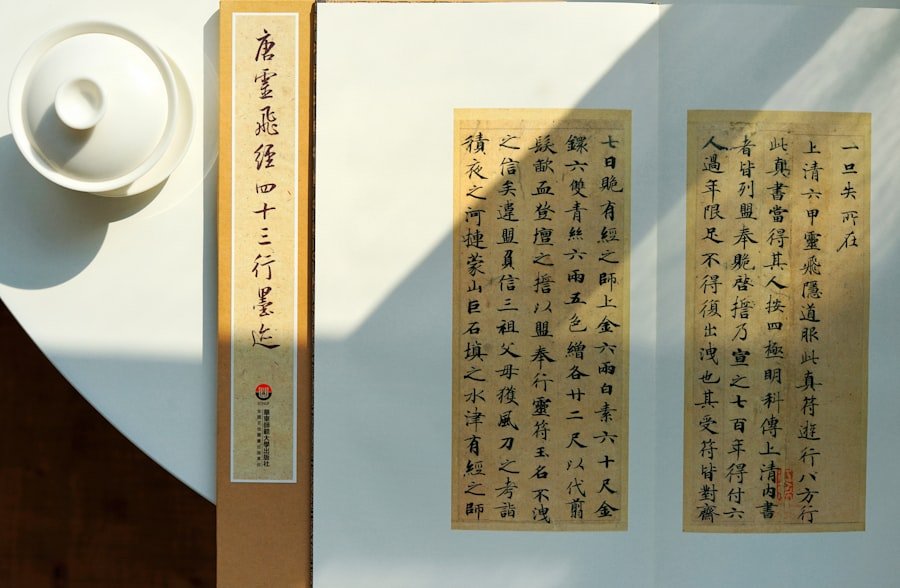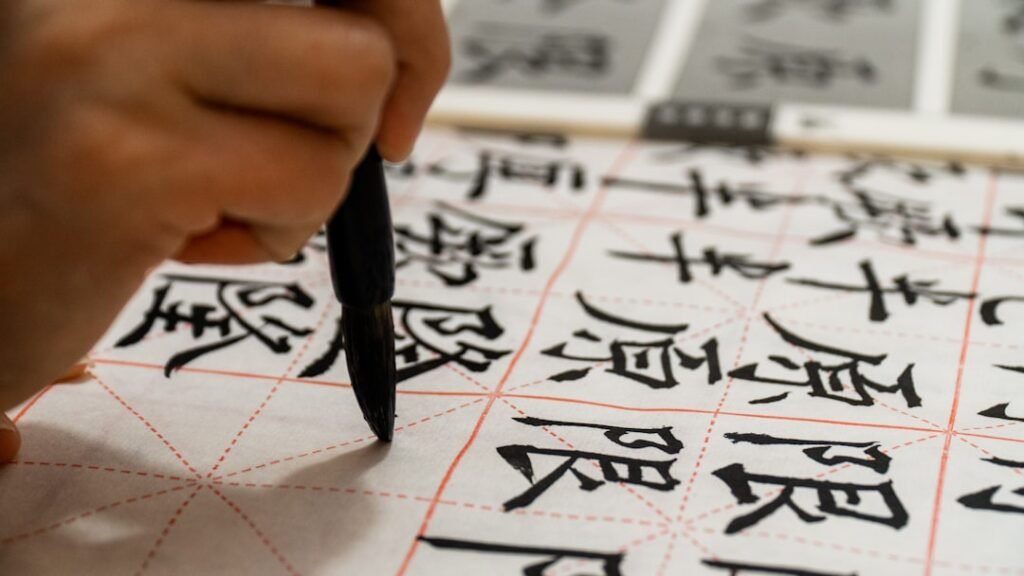Chinese calligraphy, an art form that has flourished for millennia, is deeply rooted in the rich tapestry of Chinese history. Its origins can be traced back to the Shang Dynasty (c. 1600–1046 BCE), where inscriptions on oracle bones marked the beginning of written communication in China.
These early characters were not merely functional; they were imbued with a sense of spirituality and reverence, reflecting the beliefs and values of the society at the time. As dynasties rose and fell, the art of calligraphy evolved, influenced by philosophical movements such as Confucianism and Daoism, which emphasised harmony, balance, and the importance of self-cultivation. The development of Chinese calligraphy can be seen as a reflection of the changing political and cultural landscapes throughout history.
The Qin Dynasty (221–206 BCE) standardised script forms, paving the way for a more unified written language. This period also saw the emergence of various styles, including seal script and clerical script, each with its own aesthetic qualities. As the centuries progressed, calligraphy became not only a means of communication but also a highly regarded art form, practised by scholars and emperors alike.
The Tang Dynasty (618–907 CE) is often considered the golden age of Chinese calligraphy, where masters like Wang Xizhi and Yan Zhenqing set the standards for future generations. Their works exemplified the beauty and fluidity of brush strokes, establishing a legacy that continues to inspire calligraphers today. Master the art of Chinese calligraphy. Enroll now at the LC Chinese School in Oslo.
Table of Contents
ToggleSummary
- Chinese calligraphy has a rich historical tradition dating back to ancient times, with roots in the use of oracle bones and bronze inscriptions.
- Abstract Chinese calligraphy has evolved over time, moving away from traditional representational forms to more expressive and experimental styles.
- Modern art movements such as Cubism and Abstract Expressionism have had a significant influence on the development of abstract Chinese calligraphy.
- Abstract Chinese calligraphy has transcended traditional boundaries to be recognised as a form of contemporary art, blurring the lines between calligraphy and painting.
- Abstract Chinese calligraphy continues to play a significant role in contemporary Chinese culture, serving as a means of cultural expression and identity.
The Evolution of Abstract Chinese Calligraphy
As Chinese calligraphy matured, it began to embrace abstraction, moving away from strict adherence to traditional forms. This evolution can be traced back to the late 19th and early 20th centuries when artists started to experiment with new styles that broke free from conventional constraints. The influence of Western art movements, particularly Impressionism and Cubism, encouraged Chinese calligraphers to explore abstraction as a means of expression.
This shift marked a significant departure from the rigid structures of classical calligraphy, allowing for greater personal interpretation and emotional resonance. Abstract Chinese calligraphy is characterised by its emphasis on form, line, and movement rather than legibility. Artists began to focus on the expressive potential of brush strokes, using them to convey emotions and ideas rather than merely writing characters.
This transformation was not without controversy; traditionalists often viewed abstract calligraphy as a dilution of the art form’s integrity. However, proponents argued that abstraction offered a new language through which contemporary experiences could be articulated. The interplay between tradition and innovation became a defining feature of this evolution, as artists sought to honour their heritage while simultaneously pushing the boundaries of what calligraphy could represent.
The Influence of Modern Art Movements on Chinese Calligraphy

The 20th century witnessed a profound transformation in the landscape of Chinese calligraphy, largely influenced by modern art movements that emerged both in China and abroad. The introduction of Western artistic concepts prompted calligraphers to reconsider their practices and embrace new techniques. Movements such as Surrealism and Abstract Expressionism resonated with many artists who sought to express their inner thoughts and emotions through their work.
This cross-pollination of ideas led to a rich dialogue between Eastern and Western artistic traditions, resulting in innovative approaches to calligraphy. One notable figure in this movement was Xu Beihong, who integrated Western painting techniques into his calligraphic practice. His work exemplified a synthesis of styles, blending traditional Chinese brushwork with Western realism.
Similarly, artists like Zhang Daqian experimented with colour and form, creating pieces that transcended conventional boundaries. This fusion not only expanded the vocabulary of Chinese calligraphy but also positioned it within a global context, allowing it to engage with contemporary artistic discourses. As modern art movements continued to evolve, so too did the possibilities for abstract Chinese calligraphy, leading to an ever-expanding array of styles and interpretations.
The Blurring of Boundaries: Abstract Chinese Calligraphy as Art
The emergence of abstract Chinese calligraphy has led to a blurring of boundaries between traditional calligraphy and contemporary art forms. No longer confined to the realm of writing, abstract calligraphy has been embraced as a legitimate form of artistic expression in its own right. This shift has prompted artists to explore new mediums and techniques, incorporating elements such as installation art and performance into their practice.
The result is a dynamic interplay between text and visual art that challenges preconceived notions of what constitutes calligraphy. Exhibitions showcasing abstract Chinese calligraphy have gained prominence in galleries around the world, further solidifying its status as an art form. Artists are now able to engage with audiences in ways that transcend language barriers, using visual elements to convey meaning and emotion.
This evolution has also sparked discussions about the role of the viewer in interpreting abstract works; unlike traditional calligraphy that often conveys specific messages or sentiments, abstract pieces invite personal reflection and interpretation. As boundaries continue to blur, abstract Chinese calligraphy stands at the forefront of contemporary artistic practice, embodying a unique fusion of tradition and innovation.
The Role of Abstract Chinese Calligraphy in Contemporary Chinese Culture
In contemporary Chinese culture, abstract calligraphy occupies a significant space within the broader artistic landscape. It serves as a bridge between tradition and modernity, allowing artists to engage with their cultural heritage while addressing contemporary issues. The rise of globalisation has led to an increased interest in cultural identity, prompting many artists to explore themes related to nationalism, memory, and social change through their work.
Abstract calligraphy provides a unique lens through which these themes can be examined, offering both personal and collective narratives. Moreover, abstract Chinese calligraphy has found its way into various aspects of daily life in modern China. From fashion design to interior decoration, elements of this art form are increasingly incorporated into contemporary aesthetics.
This integration reflects a growing appreciation for traditional arts within modern contexts, as well as a desire to preserve cultural heritage amidst rapid societal changes. As artists continue to push the boundaries of abstract calligraphy, its role in shaping contemporary Chinese culture remains vital, fostering dialogue between past and present.
The Global Impact of Abstract Chinese Calligraphy

The global impact of abstract Chinese calligraphy cannot be overstated; it has transcended geographical boundaries and cultural contexts to resonate with audiences worldwide. As artists from diverse backgrounds engage with this art form, they contribute to a rich tapestry of interpretations that reflect their unique perspectives. International exhibitions featuring abstract Chinese calligraphy have garnered attention from art enthusiasts and collectors alike, highlighting its relevance in today’s globalised world.
Furthermore, the rise of digital platforms has facilitated the dissemination of abstract Chinese calligraphy beyond traditional art spaces. Social media allows artists to share their work with a global audience instantaneously, fostering connections between creators and viewers across continents. This accessibility has led to increased collaboration among artists from different cultural backgrounds, resulting in innovative projects that blend various artistic traditions.
As abstract Chinese calligraphy continues to gain recognition on the international stage, it serves as a testament to the power of art in bridging cultural divides and fostering understanding.
The Intersection of Tradition and Innovation in Abstract Chinese Calligraphy
At the heart of abstract Chinese calligraphy lies a dynamic interplay between tradition and innovation. While contemporary artists draw inspiration from classical techniques and philosophies, they also seek to challenge established norms by incorporating new ideas and methods into their practice. This duality is evident in the works of many contemporary calligraphers who navigate the delicate balance between honouring their heritage and embracing modernity.
The exploration of new materials and technologies has further enriched this intersection. Artists are increasingly experimenting with unconventional surfaces such as canvas or digital media, expanding the possibilities for expression within abstract calligraphy. This willingness to innovate while remaining rooted in tradition reflects a broader trend within contemporary art that values both historical context and creative exploration.
As artists continue to push boundaries, abstract Chinese calligraphy stands as a vibrant testament to the evolving nature of artistic expression.
The Use of Abstract Chinese Calligraphy in Contemporary Design and Advertising
In recent years, abstract Chinese calligraphy has found its way into contemporary design and advertising, reflecting its growing popularity beyond traditional artistic circles. Designers are increasingly incorporating elements of this art form into branding strategies, product packaging, and promotional materials. The fluidity and expressiveness inherent in abstract calligraphy lend themselves well to creating visually striking designs that capture attention and convey meaning.
This trend is particularly evident in industries such as fashion and interior design, where abstract calligraphic motifs are used to evoke cultural authenticity while appealing to modern sensibilities. By integrating these elements into their work, designers not only celebrate traditional artistry but also create a dialogue between past and present that resonates with consumers seeking unique experiences. As abstract Chinese calligraphy continues to permeate various aspects of contemporary design, it reinforces its status as an influential force within popular culture.
Abstract Chinese Calligraphy in the Digital Age
The digital age has ushered in new possibilities for abstract Chinese calligraphy, transforming how artists create and share their work. Digital tools allow for unprecedented experimentation with form and colour, enabling artists to push the boundaries of traditional techniques while exploring new avenues for expression. Software applications designed for graphic design have become essential tools for many contemporary calligraphers seeking to blend technology with artistry.
Moreover, social media platforms have revolutionised how abstract Chinese calligraphy is disseminated and appreciated globally. Artists can now showcase their work to an international audience instantaneously, fostering connections with fellow creators and enthusiasts across borders. Online communities dedicated to this art form have emerged, providing spaces for dialogue and collaboration among artists from diverse backgrounds.
As technology continues to evolve, so too will the landscape of abstract Chinese calligraphy, offering exciting opportunities for innovation while preserving its rich heritage.
The Debate Surrounding the Authenticity of Abstract Chinese Calligraphy
As abstract Chinese calligraphy gains prominence within contemporary art discourse, debates surrounding authenticity have emerged among practitioners and critics alike. Traditionalists often argue that abstraction dilutes the essence of calligraphy as an art form rooted in language and meaning. They contend that true mastery lies in adhering to established techniques and styles that have been passed down through generations.
Conversely, proponents of abstract calligraphy assert that authenticity should not be confined solely to traditional definitions but rather encompass a broader understanding that embraces innovation and personal expression. They argue that contemporary artists are forging new paths within this ancient practice while still honouring its historical significance. This ongoing dialogue reflects larger conversations within the art world about what constitutes authenticity in an ever-evolving landscape where boundaries are increasingly blurred.
The Future of Abstract Chinese Calligraphy: Challenges and Opportunities
Looking ahead, the future of abstract Chinese calligraphy presents both challenges and opportunities for artists navigating this dynamic field. As globalisation continues to shape cultural exchanges, there is potential for further innovation as artists draw inspiration from diverse influences while remaining rooted in their heritage. However, this also raises questions about cultural appropriation and the need for sensitivity when engaging with traditional practices.
Moreover, as technology advances rapidly, artists must adapt their practices to remain relevant within an increasingly digital landscape. Embracing new tools while preserving traditional techniques will be crucial for ensuring that abstract Chinese calligraphy continues to thrive in contemporary contexts. Educational institutions play an essential role in this process; for instance, courses at LC Chinese School in Oslo offer aspiring artists an opportunity to learn about both traditional techniques and modern interpretations of this art form.
At LC Chinese School in Oslo, students can immerse themselves in the rich history and techniques behind Chinese calligraphy while exploring its contemporary applications through specialised courses focused on abstraction. These classes not only provide practical skills but also foster an appreciation for the cultural significance embedded within each stroke—a vital component for anyone looking to contribute meaningfully to this evolving art form. In conclusion, abstract Chinese calligraphy stands at a fascinating crossroads where tradition meets innovation—a space ripe with potential for exploration and expression within both local communities like Oslo’s LC Chinese School as well as on global platforms alike.
As artists continue pushing boundaries while honouring their heritage through this unique medium—its future remains bright indeed!
Master the art of Chinese calligraphy. Enroll now at the LC Chinese School in Oslo.







